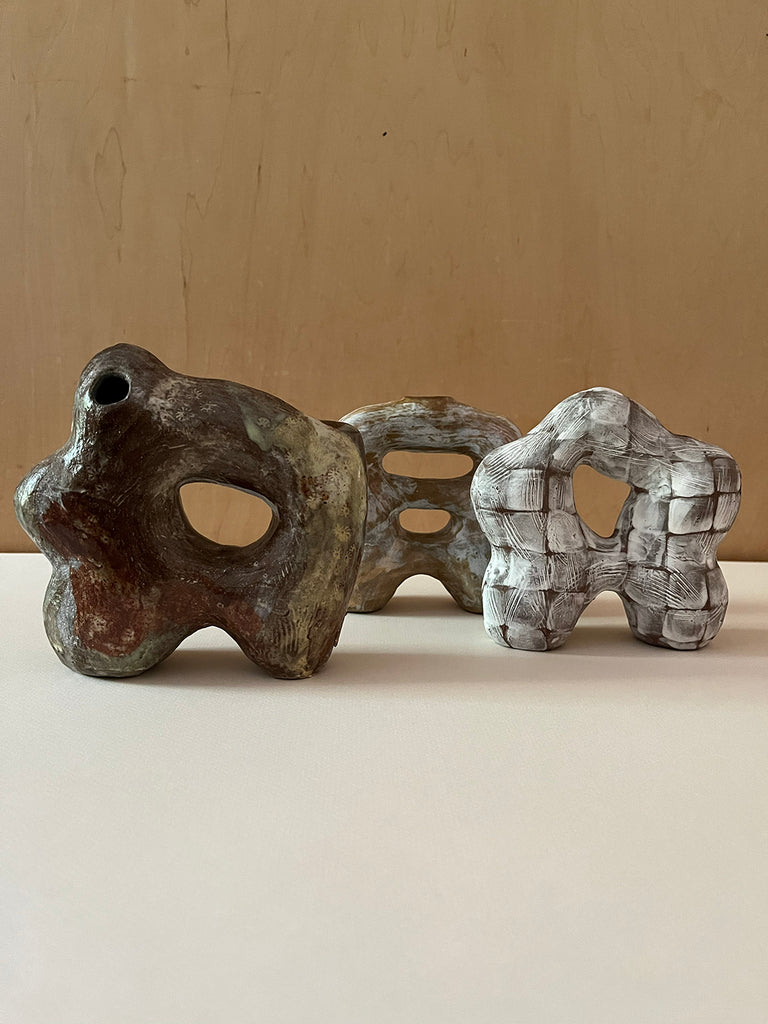Q + A with Miwa Neishi

We are pleased to now be carrying work from ceramicist Miwa Neishi. Born in Japan, and currently based in NYC, Neishi’s work has distinctive characteristics that are defined from the palette, clays, and shapes which she chooses to create with. View her pieces now both online and in store, and read more in depth about her work below.
TPE: How did you find your way into ceramics ?
Miwa Neishi: I first found my focus in creating abstract objects with terra-cotta in college in Japan. Back then, I consciously avoided making functional work due to the strictly traditional craft culture in Japan. In 2013 I began the ceramics program at Kent State University led by Kirk Mangus and Eva Kwong and immediately felt at home due to their welcoming atmosphere. It was there that I became more curious to learn about ceramics freely than when I was in Japan. When I moved to NYC I came across Sculpture Space NYC and decided I would continue working with clay by bringing functionality to my abstract work. I like the aspect of a communal ceramic studio where a group of artists share space and work together and exchange inspirations.
TPE: How long have you been working in the medium?
MW: For about 14 years including my college years.
TPE: Can you tell us a bit about the clays / glazes you work with?
MW: After learning ceramics in the US I realized the most accessible clay was manufactured in factories, made to fire with less errors, while in Japan I had used clay that was less processed and had more texture because of its natural ingredients. It was not as easy to create into forms, but I liked the feel of it and its connection to the earth. After some research I started to select locally mixed red-clay from studios in North Carolina and Kentucky. I sometimes mix them to create different colors and textures.
With glaze I like to apply it with a brush to interact with the form more directly, coating with patterns or to trace the line of its shape. I also use porcelain slip to make inlay patterns with my handmade stamps.
TPE: What colors are you drawn to, is there a palette you often work from?
MW: I’m drawn to colors deeply influenced by nature and the seasons. I like to find good combinations of colors that reflect the inspiration of the shape. In Spring I tend to use soft and light colors, in Summer I like to use blue and green, in Fall yellow and warm colors, and in Winter I tend to choose greyish blue and white… and so on. I also take a lot of hints from vintage textiles and quilts for their naturally dyed colors.
TPE: Can you tell us a little about your background / where you were born, how you came to live and work in New York?
MW: I was born in a town called Machida in west Tokyo. My parents were conscious about raising us with an international mind, so I grew up watching a lot of movies and TV shows from the US and Europe. As a child I loved studying English and art, I was always interested in learning about cultures from abroad.
My dream of studying art in a foreign country came true when I was accepted to Kent State University in 2013. I visited NYC multiple times through school trips and after finishing grad school I moved to NYC to work as a translator at Takashi Murakami’s studio in Long Island City. As I worked full-time, I continued making art after work as well as on the weekends. After 5 years, I was able to dedicate more time to make art and have it support me financially.
TPE: I read that calligraphy inspires some of the shapes / forms you work with. Can you expand upon that?
MW: From looking at my old sketches and drawings I came to realize that the lines I drew were deeply influenced by the Japanese writing structure which derives from ancient Chinese characters. I wanted to link to the history of letters and writing – and the desire in humans to communicate and share information with each other. By putting the element of calligraphy into artwork, I seek to preserve the memory of my Japanese background and create new forms, inspired by the cultural merge between East and West.
Although each artwork is unique and one of a kind there are several common shapes like legs, openings, and outlines that create the vases. Discreetly I want to show the viewer the structure of Japanese and Chinese characters, and influence the art/objects we live with.
TPE: What are 3 things that you are really enjoying right now ? (can be a place, food, show, book, song, whatever)
- Reading about Czech Cubism and Design
- Cooking anchovy pasta
- Teaching and sharing clay time with others

Follow
Facebook Instagram Pinterest